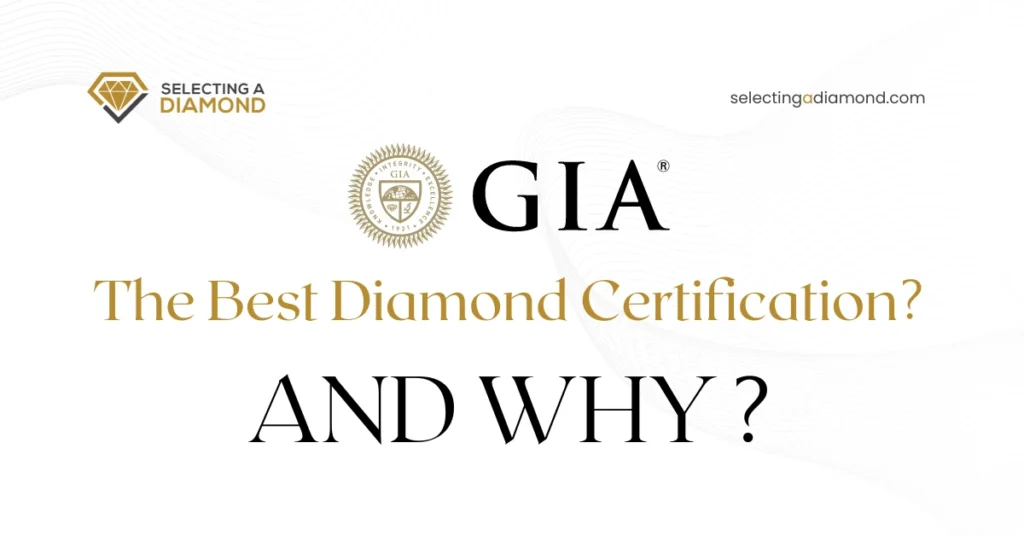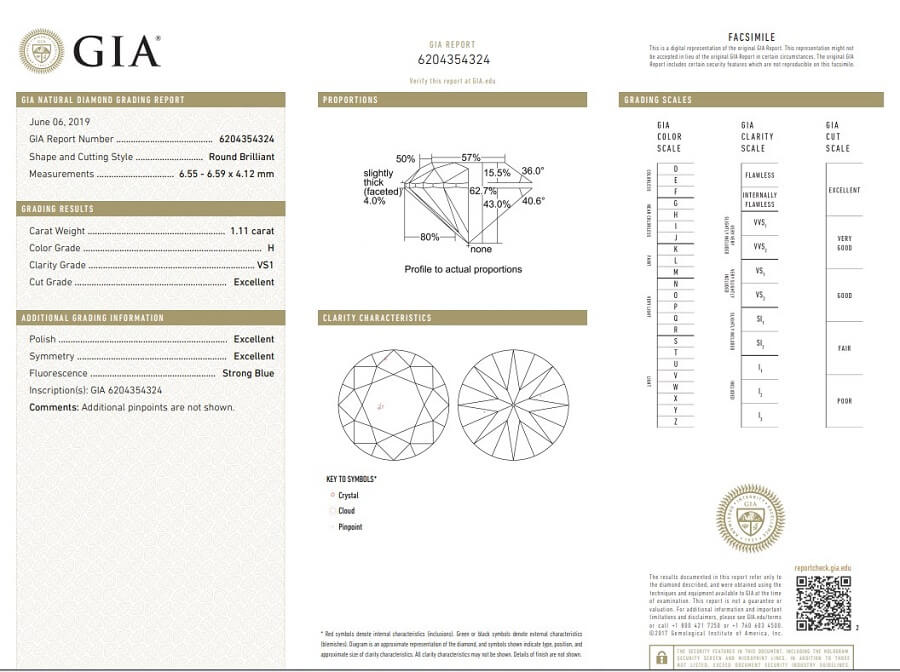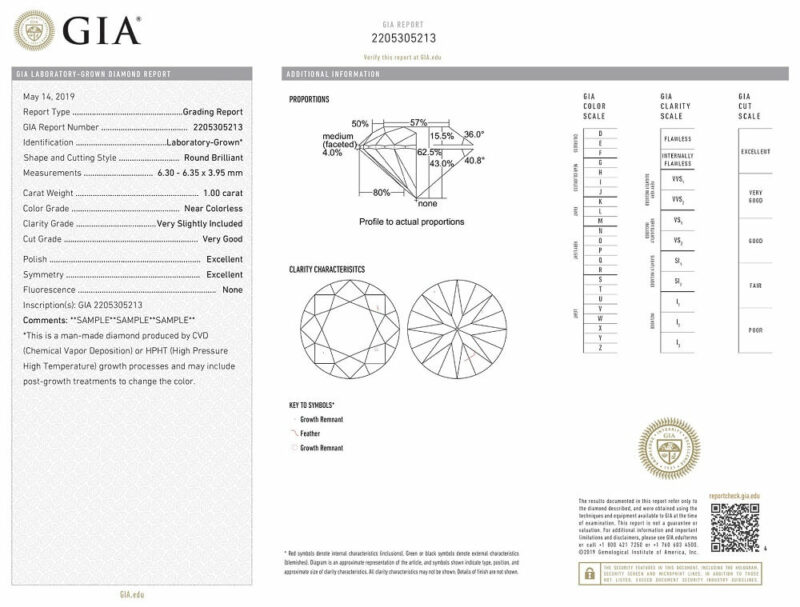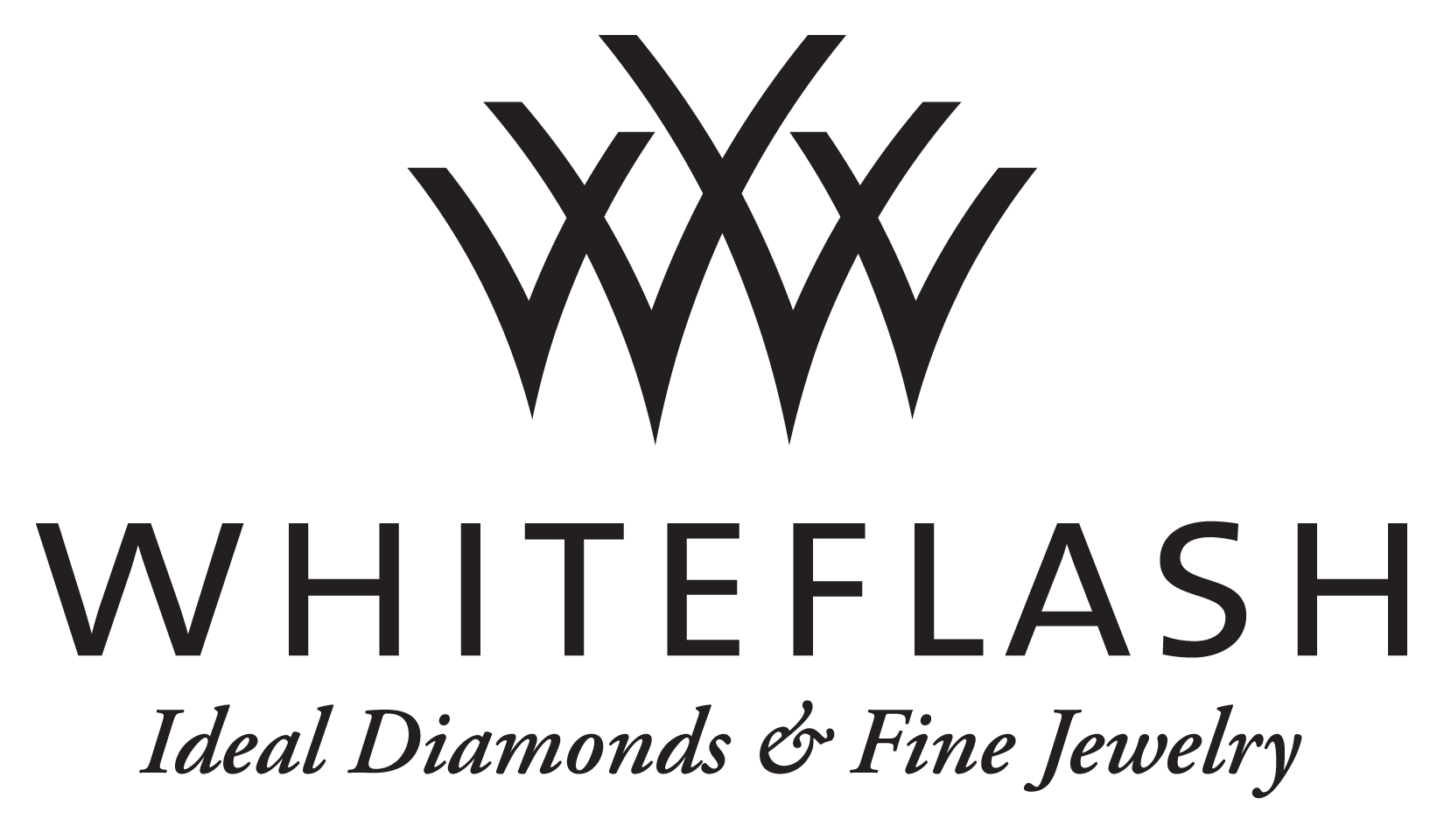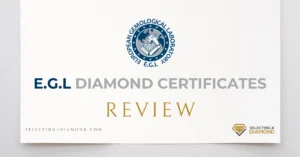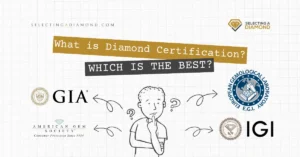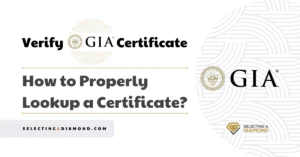According to Wikipedia, certification is formally affirming or confirming certain characteristics of an object. These certifications are typically performed by a neutral third-party entity, comprised of experts in the field.
These certifications don’t just exist for show—they hold vital specifications of the object in question. Their purpose is to instill in us the confidence in the quality of our purchases.
Now, when it comes to diamonds, there’s a veritable laundry list of factors to scrutinize before deciding on your glittering gem. Among them, the diamond certification lab stands out—no, let me correct that—it’s not just an important factor, it’s the most crucial one!
Why, you might ask? Simply because this is the lab that will grade all other elements that influence your buying decisions. From the cut, color, and clarity, to fluorescence and more, every aspect needs the scrutiny of a reputable lab.
Take a look at any diamond on websites like James Allen or Blue Nile, for instance, this stunner on JA, or this dazzling beauty on BN. You’ll swiftly observe that every diamond is accompanied by its respective certificate (and both from the GIA in these examples).
When individuals purchase diamonds, they’re not merely seeking a shiny rock—they expect the very highest quality from their jeweler. And the most reliable way to verify that is through a diamond dossier, or what is more commonly known as a diamond certification.
This is why, when you browse diamond collections on platforms like James Allen & Blue Nile, you’ll find that all their diamonds bear the seal of approval from the most esteemed certification labs like GIA & AGS. This attests to their commitment to providing only the best to their customers.
What is Diamond Certification?
Also known as a diamond grading report, diamond certification is a written attestation of a diamond’s attributes. It serves as an indicator of a diamond’s fair market value based on the characteristics documented in the certificate.
In essence, a diamond certification equips you with the knowledge you need to intelligently compare one diamond with others, be it in the same jewelry store or elsewhere.
Typically, a diamond certificate details the key attributes of a diamond, famously known as the 4Cs:
- Color: This scale ranges from D color grade (signifying a colorless diamond) to Z (a noticeably yellow diamond), indicating the extent of color, if any, present in the diamond.
- Cut: The cut grade of a diamond speaks to how well-proportioned the diamond is. It’s directly associated with the stone’s perceived sparkle (do remember not to confuse ‘cut’ with the ‘shape’ of the diamond).
- Clarity: Clarity spans from FL (Flawless) to I3 (Included), illustrating the extent of tiny blemishes present in most diamonds.
- Carat: This term denotes the weight of a diamond. Remember, we’re talking about weight, not size, as a higher carat doesn’t always correspond to a larger diamond, a point we’ve expounded on in our carat guide.
Beyond these, a diamond certification also elaborates on the diamond’s shape, measurements, symmetry, fluorescence, treatments, and any imperfections, whether they’re internal or external.
To delve deeper into this topic, feel free to peruse our comprehensive post on diamond certification.
What is the GIA Diamond Certification Lab?
In a nutshell?
The GIA, or the Gemological Institute of America, is the most globally recognized and esteemed diamond laboratory. So if you’re asking, “What is the GIA?”, the briefest answer is that it’s the world’s most trusted authority on diamonds, bar none!
A Quick Look at GIA History
The GIA, or Gemological Institute of America, is an independent non-profit organization—no one’s lining their pockets by grading diamonds here! Established way back in 1931, the GIA was designed to provide guidelines, standards, research, and education to consumers, merchants, and the entire gemstone industry.
Before GIA, buyers had to rely purely on the seller’s word, which could often be misleading. However, with the arrival of GIA and the strict standards it implemented, the diamond industry was revolutionized. Buyers are now armed with comprehensive knowledge, and the industry functions in a much more transparent manner.
The impact that GIA had reshaped the global diamond industry. Today, you can search and find real, detailed specifications for any diamond without relying solely on the jeweler’s word.
The golden rule? If it’s not mentioned in the grading report, it doesn’t exist—it’s that simple! The shopping experience we enjoy today has been molded and enhanced due to the tireless work and achievements of the GIA labs over the past 90 years.
Fast forward to 1953, GIA issued the first diamond grading report, which has since become the gold standard in the international jewelry industry.
Renowned for its unparalleled trustworthiness, the GIA is preferred among the world’s most famous and reputable jewelers. We believe this may be primarily because GIA, as a non-profit organization, plays a neutral role. They’re not advocating for the seller or the buyer—they’re the Switzerland of the diamond world!
This impartiality is crucial. In instances where labs have shareholders (i.e., they’re striving for higher profits from their lab “business”), it’s often observed that they create more ways to favor merchants, like EGL’s introduction of terms like SI3, purely for the benefit of the sellers!
GIA Labs & Locations Today
Fast forward to the present, GIA now employs over 3000 individuals across offices in 13 different countries.
GIA certification is the most universally recognized and adopted certificate for diamonds, which is easily understandable given their exceedingly high inspection standards.
But it’s not just the decades in the industry or the high standards that have earned GIA its esteemed reputation—it’s because they developed the globally accepted standardization of all diamonds: The 4Cs! That’s right, the universally followed 4Cs were brought to life by GIA.
Additionally, GIA has established itself as a leading provider of diamond education on the web.
They offer an array of online courses about diamonds that anyone can enroll in and become a GIA Alumni. They also publish a plethora of articles on Diamond Education, making it a veritable treasure trove for those interested in learning more about this dazzling world.
What is a GIA Certification/Grading?
Here’s how the process works: the jeweler or diamond merchant—usually the big names in the industry like James Allen or Blue Nile—acquire a diamond and send it to the GIA labs for grading.
Upon receiving the gem, the GIA labs carry out a thorough inspection and grading process, subsequently creating an official grading report (often referred to as a certificate) for the stone. This certificate accompanies the diamond and can be examined by customers shopping either online or in any reputable local jewelry store.
The GIA certificate (also known as the GIA grading report or chart) provides a complete, scientific, and unbiased evaluation of your diamond’s 4Cs (Carat weight, Color grade, Clarity Grade, and Cut Grade, more on these later), along with a host of other technical specifics.
Each of these attributes is carefully evaluated and reported according to the high standards GIA follows for grading diamonds. Known scales are used for this purpose, for instance, Clarity is graded based on the GIA’s 11-point clarity grades scale, while Color grading adheres to a scale running from D to Z.
But why does the GIA Color Grading Scale start with D and not A?
A fresh start!
Before the GIA introduced their grading system, gemologists followed various standards or grading scales. Some used A, B, or C, others employed Arabic numbers, while some even used Roman numerals, and so on.
Deciding to start afresh, GIA introduced a new grading system—a clean slate, so to speak—with a letter that hadn’t been used before, “D”.
What kind of Information is Listed on a GIA Report?
While we’ve touched upon some of the key details included in a GIA certificate or report, the document contains a great deal more.
For instance, let’s take a look at a real image of a GIA certificate for this diamond on Blue Nile. We’ll go over the most important elements outlined there:
1. Report Number
This is a unique number you can use to look up the diamond online and verify the originality of the report you have. Think of it as a reference number for an official document. The report number can be found at the top center of the GIA certificate, and right beneath it, the report clearly instructs you to look up this reference number on the GIA website for authentication.
Just head over to the GIA Report Check Page, enter the report number, and you will be led to a page like this one for the sample report provided earlier.
2. The 4Cs
Carat, Color (a * next to the color grade indicates that the diamond has been treated to alter its color, with additional details provided underneath), Cut, and Clarity. We’ll delve deeper into these terms shortly.
Important note: You will NEVER see a cut grade exceeding “excellent”, even for Hearts & Arrows diamonds. We’ve discussed this in more detail in our True Hearts guide, as well as in the Astor detailed review.
3. Diamond Profile
This explains the proportions of the diamond, showing elements like table & depth, facet, crown angle, and other dimensional factors.
4. Diamond Shape
This part indicates if the diamond is round, pear, heart-shaped, or any other shape. (Read: Diamond Cut vs. Diamond Shape & The Most Popular Shapes)
5. Measurements
6. Polish.
7. Symmetry.
8. Fluorescence.
9. Clarity Characteristics
This section reveals any inclusions the diamond may have and provides detailed information about them. If your diamond weighs more than 1 carat, then this section should be located in the lower-middle part of the GIA report.
It’s worth noting that the clarity section is the MOST important thing to scrutinize on the certificate because it will tell you exactly where the inclusions are located. We “assume” that you’re examining an eye-clean diamond, making the clarity section particularly useful for understanding where these imperfections are located.
GIA is the Best Diamond Certification: Yeah or Nah?
When you’re on the brink of purchasing a gemstone, a critical factor to consider is the type of certificate accompanying that diamond, or to be more precise: which certification lab has evaluated and graded it?
However, it’s worth noting that GIA isn’t the only entity providing diamond certification. There are dozens of other certification labs out there including AGS, IGI, EGL (with numerous branches), HRD, GCAL, GSI, and the list goes on. Each lab has its own standards for grading diamonds, and one of the key attributes distinguishing one lab from another is Consistency!
You shouldn’t come across two diamonds that appear to have the same color, only to discover they’re graded 2 or 3 shades apart on the color scale. That simply isn’t supposed to happen!
Labs should also strive to maintain consistency with other “reputable” lab scalings. So, if GIA grades a diamond as having an ‘I’ color, it doesn’t make sense for EGL to grade it as ‘F’. And this incongruity occurs quite frequently with EGL.
Among all the labs in the industry, only a few truly stand out for their stringent and consistent grading: GIA, AGS, and IGI, which is rapidly gaining ground as well.
But among these three, which lab is the best?
GIA is undoubtedly our top choice, and that of many others, when selecting a diamond, closely followed by AGS.
To be honest, AGS operates on the same level as GIA in terms of grading. However, due to market dynamics and industry control, GIA happens to have a higher demand and reputation. Therefore, if you ever decide to resell your diamond, a GIA-certified one will be easier to sell and will likely fetch a better price too.
Why is the GIA Considered the Best Diamond Certification Lab?
The GIA is highly regarded for several reasons:
- It invented the 4Cs of diamond grading: Carat, Clarity, Color, and Cut, providing a standard that helps buyers find the right quality diamond.
- GIA provides comprehensive information about a diamond. Beyond the 4Cs, the certificate includes specific details, helping buyers compare options within their budget.
- A GIA-certified diamond often fetches a higher resale value, as it assures buyers of its quality.
- GIA certification assures buyers they are getting a quality product and not getting scammed, providing peace of mind.
- With the rise of synthetic diamonds, it’s harder to distinguish between natural and lab-created ones. The GIA certification protects against purchasing inauthentic diamonds. If a diamond is lab-created, its GIA report will say so.
So if you’re still wondering:
Is GIA the Best Diamond Certification?
The answer is unequivocally yes! While there are other respected labs in the market like AGS and IGI, GIA stands out as the most stringent and reliable when grading diamonds.
Please note that this isn’t meant to belittle other labs. Still, we’re ranking them based on trustworthiness. After all, if AGS or IGI weren’t credible, renowned diamond retailers like James Allen or WhiteFlash wouldn’t include their graded diamonds in their inventory.
The fact remains that GIA establishes the industry standards. They indeed invented the 4Cs, which are now used daily by almost every lab in the business!
Where I Can Buy GIA-Certified Diamonds?
GIA-certified diamonds are readily available in various locations, from your local jewelry store to online platforms like Amazon and specialized diamond retailers. Out of these options, we recommend the following three online stores:
1- James Allen
This is the largest online diamond store (it surpassed Blue Nile in 2019) and a pioneer in advanced diamond imaging technology. With 360-degree HD images and the SuperZoom feature that allows for 40x magnified zoom, James Allen lets you thoroughly inspect diamonds before purchasing.
2- Blue Nile: As a trailblazer that revolutionized the diamond shopping industry in 1999, Blue Nile offers hundreds of thousands of diamonds, many of which come with 360-degree images. This store is a great place to find any diamond you want, regardless of carat size.
3- Whiteflash: Famous for its A CUT ABOVE® Hearts & Arrows collection, Whiteflash provides high-quality, unique diamonds with a premium selection. They also offer thousands of GIA-graded diamonds for you to browse and purchase.
How Can I Submit a Diamond to be Assessed by GIA?
If you have a diamond you’d like graded, you can submit it to GIA for assessment, which includes details on its cut, clarity, and carat. The cost for this report, starting from $48 for diamonds weighing between 0.15-0.22 carats, varies based on the diamond’s weight.
Visit the “Submit a Gem” page on the GIA website, select the diamond type, and follow the provided instructions.
You may wonder why resubmit a GIA-certified diamond. In most cases, you wouldn’t need to. However, it may be useful if the report is outdated and you plan to resell the gem, if you need to verify an existing report, or if the diamond has been recut.
The report offers impartial analysis of your diamond, reinforcing its stated value. Therefore, it’s crucial to always buy a diamond with a GIA certificate. There’s a distinction between a GIA-certified diamond and a diamond certified by a GIA-trained gemologist.
A GIA-certified Diamond is graded by an independent GIA facility, while a GIA-trained gemologist certification signifies that a jewelry store employee trained by GIA has graded the diamond, which may not necessarily align with GIA’s strict standards. Hence, always verify a diamond’s authenticity with a GIA certificate and buy from reliable online stores like James Allen or Blue Nile.
Summary
It’s important to always aim for a diamond with a GIA certificate, keeping in mind the difference between a GIA-certified diamond and one certified by a GIA-trained gemologist.
A GIA-certified diamond undergoes grading at an independent GIA facility, ensuring its quality with an official GIA grading report. Conversely, a GIA-trained gemologist certification implies the diamond has been graded by a jewelry store employee trained by GIA.
It doesn’t carry a GIA certification, and it may not adhere to GIA’s stringent standards, since these stores typically lack advanced grading tools.
Despite persuasive sales tactics and high price quotes from gemstone sellers, always insist on verifying a gem’s authenticity with a GIA certificate. It’s advisable to request a copy of the GIA Grading Report for any diamond you’re considering, as it acts as your assurance of quality.
For an even safer bet, consider purchasing from reliable online stores such as James Allen or Blue Nile.
Still not sure where to buy your diamond?
We always recommend shopping diamonds online and created a Full guide to shop diamonds like a Pro.
Among online retailers, here are our favorite stores click their logo to visit store
-
James Allen:
Our favorite online store, best diamond imaging technology available today, comes with the largest collection with more than half a million loose diamonds.
-
Blue Nile:
Widest collection of loose diamonds of all sizes, great imaging technology for most of their inventory (hundreds of thousands of diamonds), great customer support.
-
Whiteflash:
Home Of A CUT ABOVE® Super Ideal Diamonds, they stand out from the crowd by offering premium diamonds cuts, tailored to those who love the details, at great prices too.

